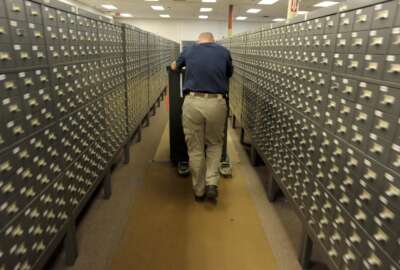

The FBI’s Criminal Justice Information Services, nearly seven years after piloting the concept, will add iris recognition technology to its portfolio of...
The FBI’s Criminal Justice Information Services, nearly seven years after piloting the concept, will add iris recognition technology to its portfolio of identification services for law enforcement agencies.
Kimberly Del Greco, the FBI’s deputy assistant director for criminal justice information services, said the CJIS Advisory Policy Board and FBI Director Chris Wray recently approved the iris-recognition technology.
Capturing iris images, Del Greco added, can be “easily integrated” into the existing biometric process using near-infrared cameras. All iris images added into the FBI’s searchable iris image repository must be associated with fingerprints submitted as part of an arrest.
The bureau launched its iris recognition pilot in 2013, according to a recent Government Accountability Office report, with the intention of helping criminal justice agencies quickly and accurately identify or confirm someone’s identity.
“An iris offers highly accurate, contactless and rapid biometric identification option for agencies. The iris contains a unique pattern of ridges and folds that are specific to an individual,” Del Greco said Tuesday at AFCEA’s Federal Identity Forum.
The iris recognition service will go live in October as the latest improvement in the bureau’s growing portfolio of biometric services.
Scott Rago, the section chief of biometric services at CJIS, said law enforcement primarily collect iris images during the booking and fingerprinting process. These iris images, he added, need to be captured in with a near-infrared camera and taken less than two feet away from the subject.
Because of these requirements, these iris scans can’t be pulled from mugshots or other photographs.
“Although it’s currently being researched, this isn’t possible,” Rago said. “Unless you’ve got a very high-definition camera that can capture an iris image in near-infrared, anything beyond about 18 inches is really not possible.”
Rago said local law enforcement agencies have used iris scans to track inmates and as a secondary biometric identifier for suspects with poor-quality fingerprints.
While Congress remains wary of facial recognition technology — and some Democratic lawmakers have introduced legislation this summer to prohibit its use in the federal government — the FBI last November updated its facial recognition algorithm that searches a repository of more than 43 million criminal-history mugshots.
Del Greco said the updated algorithm has an accuracy rate higher than 99% and that law enforcement agencies use this technology for the “development of investigative leads.”
“The improved accuracy builds even more confidence in our systems and increases the ability for our partners to rely on face-recognition searches for vital investigative leads,” she said.
Meanwhile, the FBI is looking at using artificial intelligence and machine learning to build a tool that can detect intentionally altered fingerprints.
“In these cases, criminals deliberately worked to change their fingerprint patterns through cuts, burns or other self-induced disfigurements in an attempt to mask their identity,” Del Greco said. “It is their intention to use their altered fingerprints to defeat automated biometric systems like the Next Generation Identification System.”
Through automation, the FBI has also made it easier for the public to access or challenge their own criminal history records. By automating the response system for Electronic Departmental Order (EDO) requests and challenges, the FBI has been able to cut processing times from 18 weeks on only one week.
Meanwhile, the FBI is building momentum with the Postal Service on providing biometric services. Since September 2018, more than 80 post offices across the country have offered fingerprinting services. Del Greco said the bureau and USPS will expand this pilot later this fall by expanding it to 20 more post offices.
And those discussions led to an investigation of how the IRS and USPS might collaborate to provide in-person identity proofing for taxpayers who can’t successfully authenticate online.
Courtney Rasey, a senior technical advisor to the director of identity assurance at the IRS, said the agency has been in talks with USPS and the General Services Administration for post offices to provide identity proofing for taxpayers who can’t successfully authenticate themselves online.
Copyright © 2024 Federal News Network. All rights reserved. This website is not intended for users located within the European Economic Area.
Jory Heckman is a reporter at Federal News Network covering U.S. Postal Service, IRS, big data and technology issues.
Follow @jheckmanWFED



